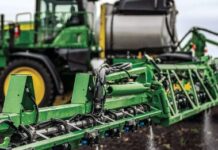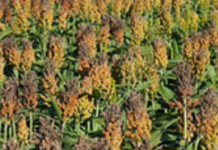The National Bio & Agro Defense Facility sign shows a cow, a pig and a sheep, which are the primary livestock that will be used in disease researh at the new labe NBAF in Manhatttan. After well over a decade of politics, applications, funding debates and construction, the National Bio and Agro-Defense Facility is officially open.
But the federal government’s newest biosecurity laboratories in Manhattan are still likely more than a year away from performing the animal health research they were designed for.
Dignitaries celebrated NBAF’s opening in the animal health corridor with a ribbon cutting ceremony on Wednesday.
Officials provided area media with a tour of the labs last week, highlighting safety precautions, but photos and detailed notes were strictly prohibited in the interest of security.
The lab’s mission is to protect American agriculture, farmers and citizens against animal diseases that threaten the food supply, agricultural economy and public health.
That means working with newer diseases and ones that can spread from livestock to humans. Experts study to prevent, surveil, diagnose and respond to diseases, including managing vaccine banks and developing new vaccines and antivirals.
While work is happening at NBAF, they are not yet performing research in the labs.
Staff are doing various compliance and regulatory work, inspections, developing and testing protocols and standard operating procedures, preparing equipment and training before working with any pathogens.
“They will check all the systems according to the international standards and national standards,” Alfonso Clavijo, the NBAF director, said of the inspections. “And only after we have that approval will we be able to actually do any work. We expect that by late 2024, we should be able to have that approval.”
Officials characterized NBAF scientists as being at the crawling stage before learning to walk, jog and run. Once they design the procedures, they will be tested on clean animals before animals with less risky pathogens, then animals with riskier zoonotic diseases and finally the most risky zoonotic diseases the BSL-4 lab is designed to handle.
“Safety and security is the primary goal,” said Ken Burton, the NBAF deputy director. “And we don’t do anything to move into science until we feel that everything is safe and secure to be able to do that.”
How are the pathogens getting to Manhattan?
The pathogens have not yet been moved from Plum Island to NBAF.
“What I can share is that very experienced federal partners are going to be handling the transfer of the scientific materials,” said Katie Pawlosky, the NBAF communications director. “No animals, no equipment, will transfer.
“As far as timeline, I don’t know that we have that information yet. We’re still working through our science preparatory phase. We won’t be able to begin any of that until we’re ready, but it will be a phased process done very safely and securely. But for the safety and security of the process, we can’t really disclose details.”






